
Table of Contents
Scientific Classification
- Kingdom: Animalia
- Phylum: Chordata
- Class: Reptilia
- Order: Squamata
- Family: Agamidae
- Genus: Uromastyx
- Species: U. ornata
Quick Overview
The Ornate Uromastyx, distinct for its vibrant coloration and intricate patterns, is a sought-after species among reptile enthusiasts. Hailing from the Arabian Peninsula, these desert dwellers have a robust build and a striking spiky tail, making them a standout in the Uromastyx family.
Fast Facts
- Scientific Name: “Uromastyx ornata”
- Lifespan: 15-20 years in captivity
- Average Size: 10-15 inches
- Diet: Herbivorous
- Habitat: Desert environments
Did you know?
The term “ornata” in its scientific name refers to its ornate, decorative patterns and vivid coloration.
Appearance
Ornate Uromastyx are known for their radiant hues, often a mix of green, yellow, and blue, with intricate patterns lining their dorsal sides. This coloration and pattern complexity can vary, making each individual unique.
Size and Weight
Typically, adult Ornate Uromastyx lizards range from 10 to 15 inches in length. While their weight can vary, mature individuals usually weigh between 250 to 400 grams.
Temperament and Behavior
These reptiles are generally docile and, with consistent and gentle handling, can become rather sociable. They are diurnal creatures, basking during daylight hours and retreating to their burrows during the cooler nights.
Fun Fact:
Ornate Uromastyx have a wedge-shaped head which aids in digging and burrowing, an essential skill in their natural, arid environment.
Habitat and Distribution
Native to the Arabian Peninsula, particularly Yemen and Saudi Arabia, these lizards inhabit hot, rocky deserts and semi-desert terrains.
Care Guide
If you’re considering an Ornate Uromastyx as a pet:
- Provide a spacious terrarium with a good basking spot.
- Ensure a temperature gradient, with basking areas reaching 100-110°F.
- UVB lighting is vital for proper calcium metabolism.
- Offer a substrate conducive for digging, like a sand and soil mixture.
- Their diet should comprise seeds, leafy greens, and occasional vegetables.
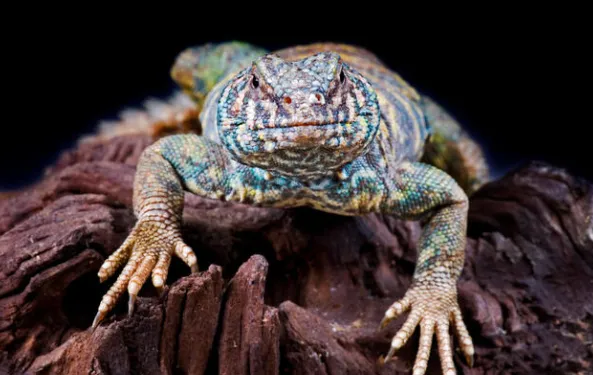
Diet and Nutrition
Being herbivores, they relish a mixture of seeds, legumes, and green leafy vegetables. It’s crucial to supplement their diet with calcium and ensure they get adequate nutrients.
Health and Wellness
Keep an eye out for signs of dehydration, metabolic bone disease, and impactions. Regular health checks with a reptile specialist are always a good practice.
Breeding
After a brumation period, breeding can occur. Once mated, females will lay their eggs in sandy, warm locations. The incubation period varies based on temperature and humidity.
Conservation Status
The Ornate Uromastyx’s conservation status varies, but habitat destruction and illegal pet trade pose threats. Some regions have protection measures in place to preserve their populations.
Fun Fact:
Like other Uromastyx species, the Ornate Uromastyx reabsorbs water from its waste, ensuring maximum hydration in its naturally arid environment.
Photo Gallery
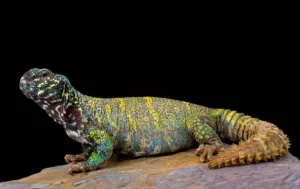
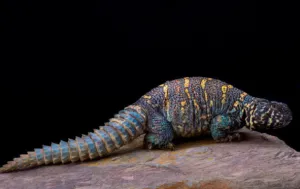
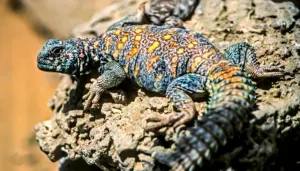
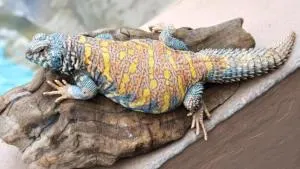
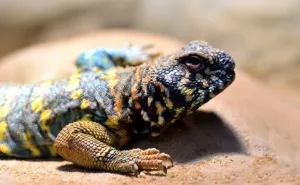
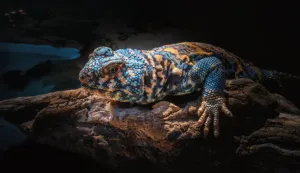
Check out the video below of an Ornate Uromastyx making some cool moves!
Related Profiles
Share This Profile:
3 Amazing Facts About Ornate Uromastyx
- Desert Camouflage: Despite their bright colors, the Ornate Uromastyx’s pattern serves as an effective camouflage, blending seamlessly with the rocky terrains and shrubs of its habitat.
- Tails as Weapons: Their thick, muscular tails aren’t just for show. When threatened, they can use them as whips against potential predators.
- Vegetarian Giants: One of the larger Uromastyx species, the Ornate is strictly herbivorous. Their digestive systems have evolved to extract moisture from the plants they eat, a crucial adaptation for desert living.
- Enchi Ball Python: A Unique and Stunning Morph of Python regius - March 27, 2025
- Emerald Tree Monitor: The Enigmatic Green Guardian of the Rainforest - March 26, 2025
- The Egyptian Cobra (Naja haje): A Fascinating Serpent - March 25, 2025
